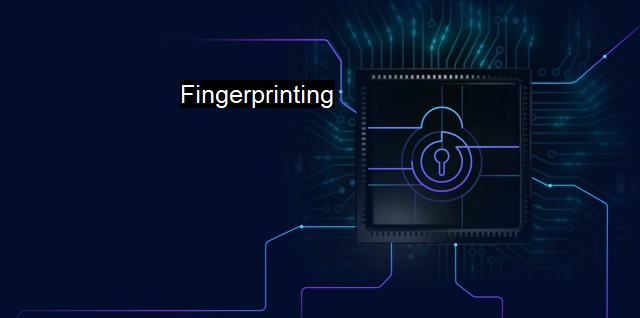What is Fingerprinting?
The Power of Fingerprinting in Cyber Security: Detecting Malware, Securing Networks, and Identifying Software at a Glance
Fingerprinting in the context of cybersecurity and antivirus is a technique used to gather information or identify user devices, software, operating systems or anyone who uses the internet, including hackers. The concept of fingerprinting in this field may at times prove to be controversial since it loosely hangs in the imbalance of security versus privacy.The main goal of fingerprinting is to identify, monitor, or track the activities, behaviours, and the state of a system or network. For instance, operators can use it to study the traffic that flows to and from a system or network. From these, anomalies that indicate an external attack or suspicious activities within the network can be spotted.
In the antivirus realm, fingerprinting is also prevalent. Antivirus software suites use fingerprinting to identify malicious or harmful files by cross-checking them with their unique fingerprints, like signature-based detection. The important idea is that all files, whether harmless or harmful, have unique characteristics or attributes. When these unique characteristics are identified or isolated, they form what practitioners refer to as the fingerprint of the file.
The antivirus software collects, processes these fingerprints, and places them in a database. As new files enter or leave your system, the antivirus software cross-checks their fingerprints against the ones in its database. If the specific match is found, the response of the antivirus software depends on whether the fingerprint belongs to the category of benign or harmful files. fingerprinting in antivirus software is quite akin to the fingerprinting technique in forensic science, where the culprits are apprehended on the basis of whose fingerprints match the suspicious ones gathered from the crime scenes.
An application of fingerprinting in cybersecurity is a device fingerprinting where every device that connects to a network or the internet produces a unique identifier or a fingerprint. Such unique signatures can be created based on device characteristics like the MAC address, the IP address or the device's browser settings. So, when the device tries to connect to a network, its definitive fingerprint can validate its identity.
Fingerprinting can also take place at the network layer through what is known as network fingerprinting. In this type of fingerprinting, the focal point is the features associated with the networking protocol such as TCP, or IP. By analyzing these feature sets, network footprints of packet round-trip times, the window size of TCP sessions, packet order, among other variables can help to identify the device or system.
On the flip side, fingerprinting at the application layer focuses primarily on generating identifying information on the basis of how applications send and receive traffic. This approach can reveal the type, the version, and even the configuration details of applications running on a network or system.
Always remember that while fingerprinting is an effective method to enhance the security posture of your systems by detecting threats and limiting the attack surface, the technique invites privacy concerns. It's a widespread belief that while fingerprinting in cybersecurity is beneficial for organizations, it tends to jeopardize the privacy of individuals browsing the internet. Thus, striking the right balance is greatly crucial.
Fingerprinting is a key tool providing valuable input for system identification, intrusion detection, and supporting forensics analysis. It helps security operators and antivirus suites spot deviations, anomalies, or threats in their early stages before they escalate into large-scale attacks. Despite its privacy implications, more sophisticated fingerprinting methods are constantly being developed to provide users with secure internet experiences.

Fingerprinting FAQs
What is fingerprinting in cybersecurity?
Fingerprinting in cybersecurity is the process of gathering information about a target system in order to identify its unique characteristics and vulnerabilities. This information can be used to launch targeted attacks or to develop defenses against potential threats.Why is fingerprinting important in antivirus software?
Fingerprinting is important in antivirus software because it helps to identify specific malware threats and develop effective countermeasures. By analyzing the unique characteristics of a malicious program, such as its code signatures or behavior patterns, antivirus software can recognize and protect against similar threats in the future.What are some techniques used in fingerprinting?
Some common techniques used in fingerprinting include port scanning, network mapping, banner grabbing, and service enumeration. These methods involve probing a target system to gather information about its operating system, applications, and network configurations.Is fingerprinting always used for malicious purposes?
No, fingerprinting can be used for both offensive and defensive purposes in cybersecurity. It can be used by security professionals to identify potential vulnerabilities in their own systems and implement appropriate safeguards. However, it can also be used by attackers to gather information about a target system in order to launch more effective attacks.Related Topics
Biometric authentication Identity verification Malware detection Intrusion detection Cybersecurity threats
| | A | | | B | | | C | | | D | | | E | | | F | | | G | | | H | | | I | | | J | | | K | | | L | | | M | |
| | N | | | O | | | P | | | Q | | | R | | | S | | | T | | | U | | | V | | | W | | | X | | | Y | | | Z | |
| | 1 | | | 2 | | | 3 | | | 4 | | | 7 | | | 8 | | |||||||